Mwanza is a beautiful city in Tanzania that is home to a wide variety of bird species. The city is located on the southern shores of Lake Victoria and is an important stopover for migrating birds.
From the iconic flamingos to the colorful weavers, Mwanza is a bird-watchers paradise. The area is also home to a wide variety of raptors, such as the martial eagle, which are often seen soaring over the city’s skyline.
There are also numerous water birds, such as the African fish eagle, which can be seen searching for fish in the lake. The forests that surround Mwanza are also home to numerous species of birds, including the striking turacos and the vibrant yellow-necked spurfowl.
All in all, Mwanza is an ideal destination for anyone who loves birds.
1. Grey-Crowned Crane
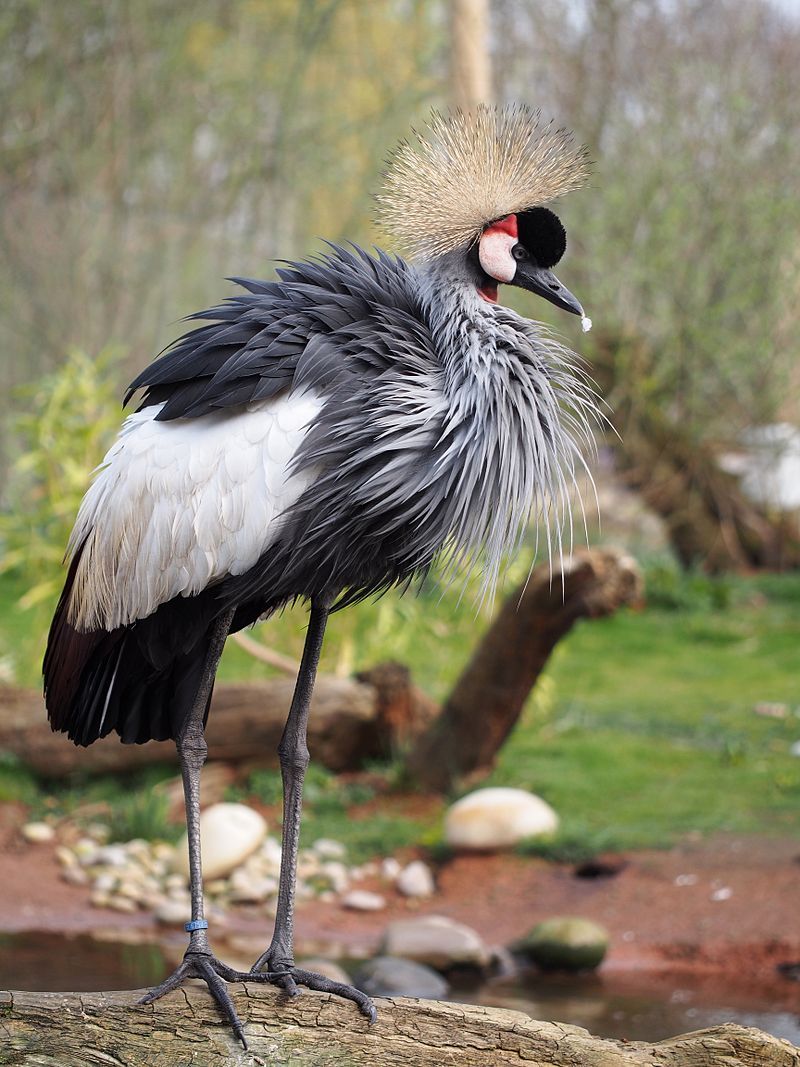
The Grey Crowned Crane is a species of bird which is part of the crane family, Gruidae.
It is found in Africa and is also known by many other names, including African Crowned Crane, Golden Crested Crane, Golden Crowned Crane, East African Crane, East African Crowned Crane, African Crane, Eastern Crowned Crane, Kavirondo Crane, South African Crane and Crested Crane. This species of crane is a large, stately bird with a wingspan of up to 2.3 meters.
It is grey, with a white crown and bright golden feathers on its head and neck. It has a long, curved neck and a large, broad bill. The legs and feet are grey in color. The Grey Crowned Crane is an omnivore, feeding on a variety of animal and plant foods.
It eats insects, fish, frogs, worms, small mammals, grains, and other plant material. It also scavenges for food. The Grey Crowned Crane is a social bird, living in pairs or in family groups.
It is an active bird, walking and running on the ground and taking off in flight to cover large distances.
It is also a very vocal bird, making loud, trumpeting calls. The Grey Crowned Crane is an endangered species due to human activities such as hunting, loss of habitat, and pollution.
It is protected in certain countries, and captive breeding programs are in place to help the species survive.
| Kingdom | Animalia |
| Phylum | Chordata |
| Class | Aves |
| Order | Gruiformes |
| Family | Gruidae |
| Genus | Balearica |
| Species | B. regulorum |
2. Egyptian Goose
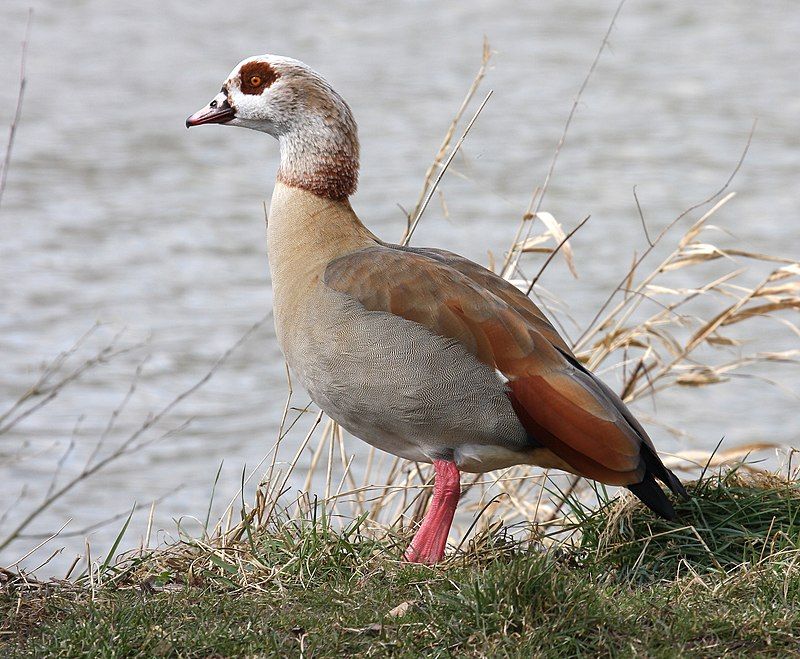
The Egyptian goose is a species of Anatidae, the family of waterfowls that includes ducks, geese, and swans. This species is native to Africa, but has been introduced to a variety of other places around the world.
The Egyptian goose is popular as an ornamental bird, which is why it has been introduced to places like Europe, the United States, and elsewhere outside of its natural range.
It is often kept as a pet or is used for decorative purposes in parks and gardens.Due to its popularity, the Egyptian goose has become a common sight in many countries. It is an interesting species with a distinctive look.
The Egyptian goose has an overall grey-brown body, with a white face and a black patch around the eyes. Its bill is yellow, and its legs and feet are orange.
The species has a wingspan of around 90 cm, and can reach a height of around 55 cm. The Egyptian goose is a social species, and often forms large flocks when out in the wild. In urban areas, they can be seen around parks and other open areas.
They feed mainly on plant matter such as grasses, seeds, and grains. In some parts of the world, the Egyptian goose is considered to be an invasive species.
This is because it can compete with native waterfowl for food and habitat, and can also cause damage to agricultural crops. It is therefore important to keep an eye on its population to ensure that it does not become a nuisance.
| Kingdom | Animalia |
| Phylum | Chordata |
| Class | Aves |
| Order | Anseriformes |
| Family | Anatidae |
| Genus | Alopochen |
| Species | A. aegyptiaca |
3. African Openbill
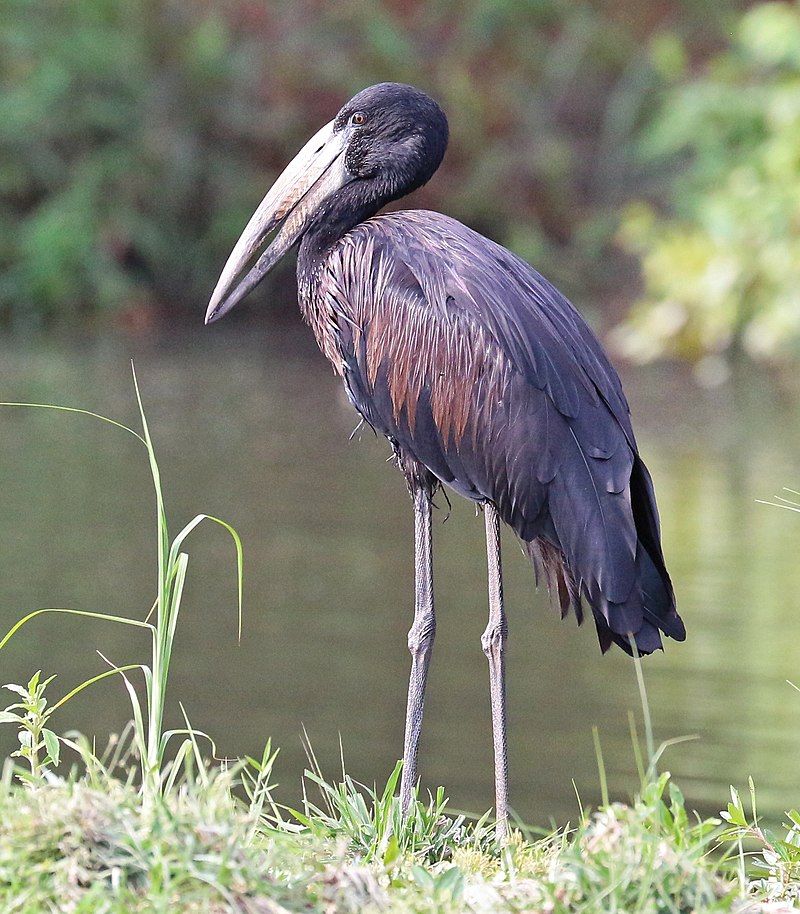
The African openbill is a stork, belonging to the Ciconiidae family of birds. It is widely distributed in the Sub-Saharan Africa region, as well as in the western parts of Madagascar.
This species of stork is considered to be common in many areas, while in some regions it may be considered abundant. Its distribution may vary from one area to another, with some areas having more of this species than others.
Its range is quite large, however, and it can be found in many different areas across Sub-Saharan Africa and Madagascar. The African openbill has an impressive wingspan and can reach up to 1.2m in length.
It is a large bird, with an overall greyish-white color and black flight feathers. Its beak is curved and open, giving it its name, and it has yellow facial skin. This species of stork feeds mainly on small fish, frogs, and other amphibians.
It hunts by wading in shallow water and using its beak to snatch prey. Overall, the African openbill is a fairly common species of stork, with a wide range across Sub-Saharan Africa and Madagascar.
Although its distribution is patchy in certain regions, it is still considered common to locally abundant in many areas. This species is a beautiful sight to behold, with its impressive wingspan and its unique beak.
It is an important part of the African ecosystem and helps to keep the balance of the natural environment.
| Kingdom | Animalia |
| Phylum | Chordata |
| Class | Aves |
| Order | Ciconiiformes |
| Family | Ciconiidae |
| Genus | Anastomus |
| Species | A. lamelligerus |
4. Lesser Flamingo
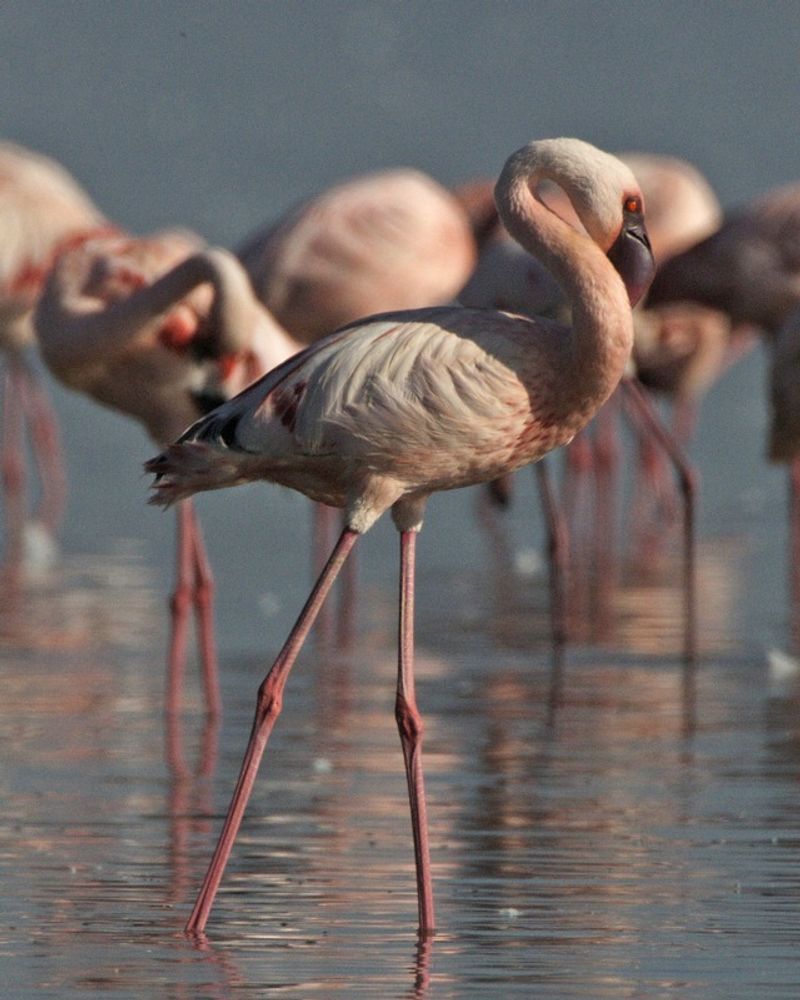
The lesser flamingo is a species of flamingo commonly found in sub-Saharan Africa and western India. It is characterized by its pinkish-white feathers and long legs.
Although this species of flamingo is generally found in these two regions, there have been occasional reports of birds being spotted in further north areas.
However, these sightings are typically considered to be mere vagrants, as the lesser flamingo does not usually reside in these areas. Fortunately, the species is not currently threatened and its population is currently stable.
| Kingdom | Animalia |
| Phylum | Chordata |
| Class | Aves |
| Order | Phoenicopteriformes |
| Family | Phoenicopteridae |
| Genus | Phoeniconaias |
| Species | P. minor |
5. Marabou Stork
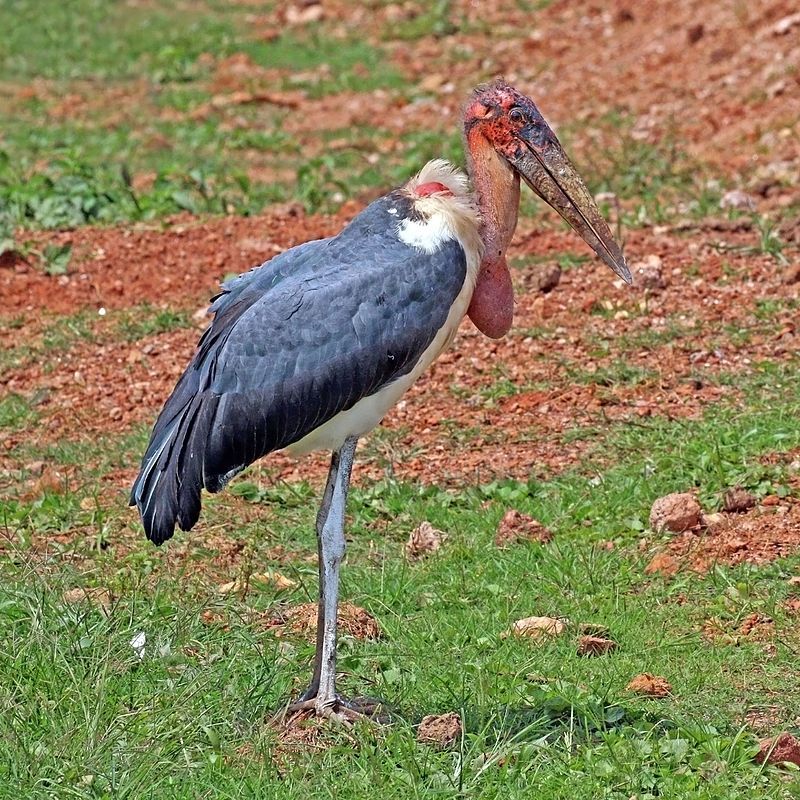
The marabou stork is an impressive large wading bird that belongs to the stork family Ciconiidae. It is native to sub-Saharan Africa, and can be found in both wet and arid habitats. Interestingly, it is also known to nest near human habitation, especially around landfill sites.
With its bare head and neck, as well as its large size, the marabou stork is an easily recognizable bird. It is white in color with black flight feathers, and its wingspan can reach up to 2.5 meters.
As a scavenger, the marabou stork feeds on a variety of food items, ranging from carrion to small animals and insects. This bird is also a social species, and can often be seen in groups or flocks.
The marabou stork is an important species in its African habitats, and is a part of many local cultures and traditions.
| Kingdom | Animalia |
| Phylum | Chordata |
| Class | Aves |
| Order | Ciconiiformes |
| Family | Ciconiidae |
| Genus | Leptoptilos |
| Species | L. crumenifer |
6. Laughing Dove
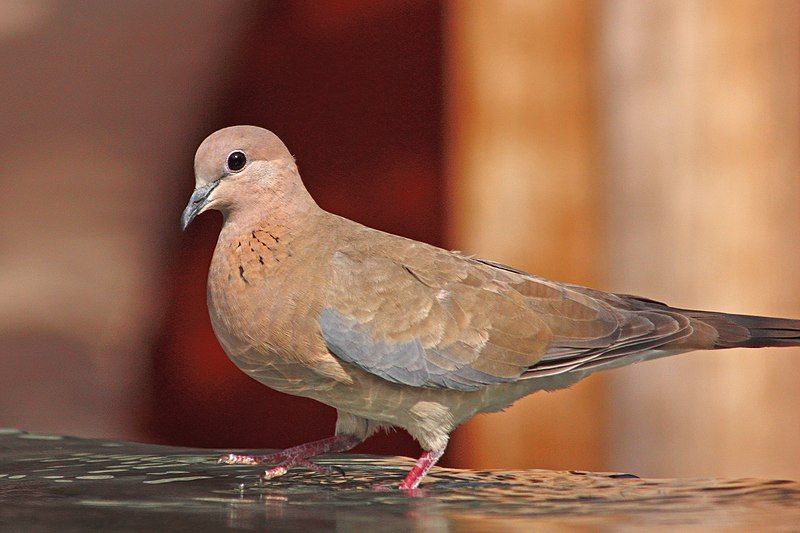
The Laughing Dove (Streptopelia senegalensis) is a small, long-tailed pigeon found in a variety of habitats across Africa, the Middle East, South Asia, and Western Australia. It is a resident breeder, meaning it produces offspring throughout the year in its natural range.
This species of dove has a distinctive call, described as a series of soft, drawn-out coos that can be heard at dawn and dusk. The Laughing Dove is a lovely bird with a greyish-brown back, a pinkish chest, and a white-tipped tail.
It has a black eye stripe and a white patch on its wings that is visible when in flight.
It feeds on seeds, fruits, and small insects, and can often be found in gardens and agricultural areas. The Laughing Dove was released from Perth Zoo in 1898 and has since become a naturalized species in Australia.
It is a common sight in the wild, often seen perched on telephone wires or perched in trees. It is a popular bird among birdwatchers and is often seen in aviaries and pet stores. Overall, the Laughing Dove is a beautiful bird that is a joy to watch in its natural habitat.
It is a very adaptable species and is able to thrive in a wide range of habitats from deserts to forests and open woodlands. It is a species that is enjoyed by many and is a great addition to any backyard.
| Kingdom | Animalia |
| Phylum | Chordata |
| Class | Aves |
| Order | Columbiformes |
| Family | Columbidae |
| Genus | Spilopelia |
| Species | S. senegalensis |
7. Little Grebe
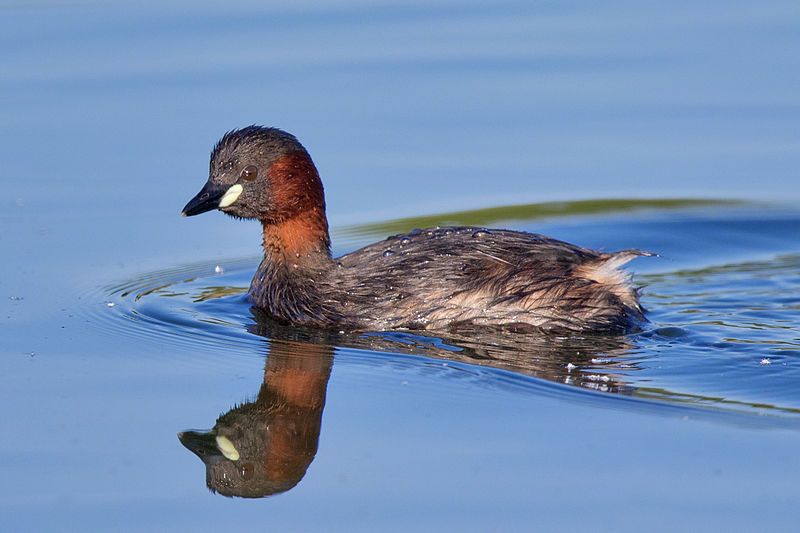
The little grebe, also known as dabchick, belongs to the grebe family of water birds. Its scientific name, Tachybaptus ruficollis, consists of two parts – Tachybaptus and ruficollis.
The term Tachybaptus comes from the Ancient Greek takhus, which means ‘fast’, and bapto which means ‘to sink under’. On the other hand, the second part of the scientific name, ruficollis, is a combination of Latin words rufus and collis.
The term rufus means ‘red’, while collis is derived from Latin collum which means ‘neck’. Thus, ruficollis literally means ‘red-necked’. This term is used to describe the distinctive reddish color on the neck of this bird.
| Kingdom | Animalia |
| Phylum | Chordata |
| Class | Aves |
| Order | Podicipediformes |
| Family | Podicipedidae |
| Genus | Tachybaptus |
| Species | T. ruficollis |
8. Greater Flamingo
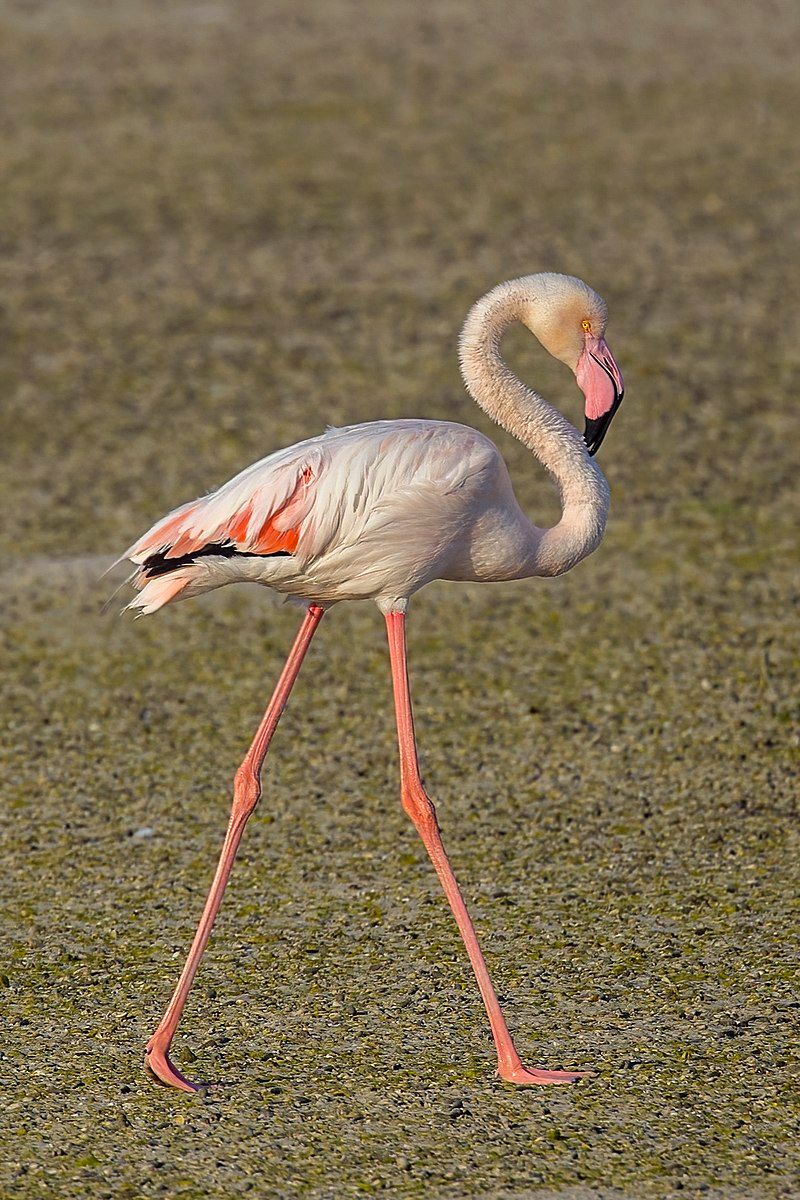
The greater flamingo is one of the most well-known species of flamingos, and it is the most widespread and largest of its kind.
The species is native to the Old World, meaning that it is found throughout areas of Northern and Sub-Saharan Africa, the Indian Subcontinent, the Middle East, the Levant, the Persian Gulf, the Gulf of Aden, the Red Sea, and Southern Europe.
This expansive range of habitats allows the greater flamingo to thrive in many different locations, often near large bodies of water, such as lakes and coastlines. The greater flamingo is well-known for its distinct appearance, including its long neck and legs, as well as its bright pink feathers.
It also has a unique bill, which is curved downwards and is often bright red in colour. The flamingo is a wading bird, which means that it will often be found in shallow waters, using its bill to filter out small creatures on which it will feed.
In addition to this, the bird will also eat seeds and algae. The greater flamingo is a social species, often living in large flocks. This behaviour allows the birds to benefit from communal protection and support.
These flocks can range in size from a few dozen to a few thousand, depending on the habitat and availability of food. Overall, the greater flamingo is an iconic species of the Old World, and its widespread range and large numbers make it an important part of the environment.
It is an impressive bird which is sure to capture the attention of anyone fortunate enough to witness it.
| Kingdom | Animalia |
| Phylum | Chordata |
| Class | Aves |
| Order | Phoenicopteriformes |
| Family | Phoenicopteridae |
| Genus | Phoenicopterus |
| Species | P. roseus |
9. Hamerkop
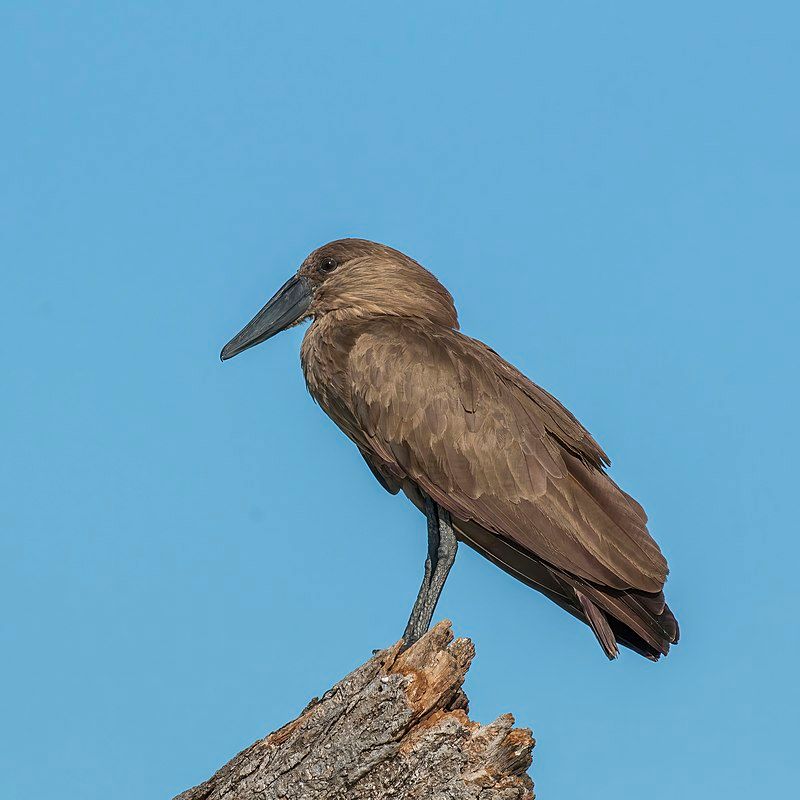
The hamerkop is a medium-sized wading bird that is the only living species in the genus Scopus and family Scopidae. For a long time, it was believed that the species and family were part of the Ciconiiformes, which includes storks and herons.
However, recent research has placed the hamerkop with the Pelecaniformes, a group that includes pelicans, cormorants, and gannets. The hamerkop is thought to be most closely related to pelicans and the shoebill, a large stork-like wading bird.
The hamerkop is an interesting species, as it is the only one in its genus and family and has been placed in two different bird orders throughout its history.
It has a unique appearance, with its long, sharp bill and humped back, and is found in wetlands and woodlands throughout sub-Saharan Africa.
| Kingdom | Animalia |
| Phylum | Chordata |
| Class | Aves |
| Order | Pelecaniformes |
| Family | Scopidae |
| Genus | Scopus |
| Species | S. umbretta |
10. Helmeted Guineafowl
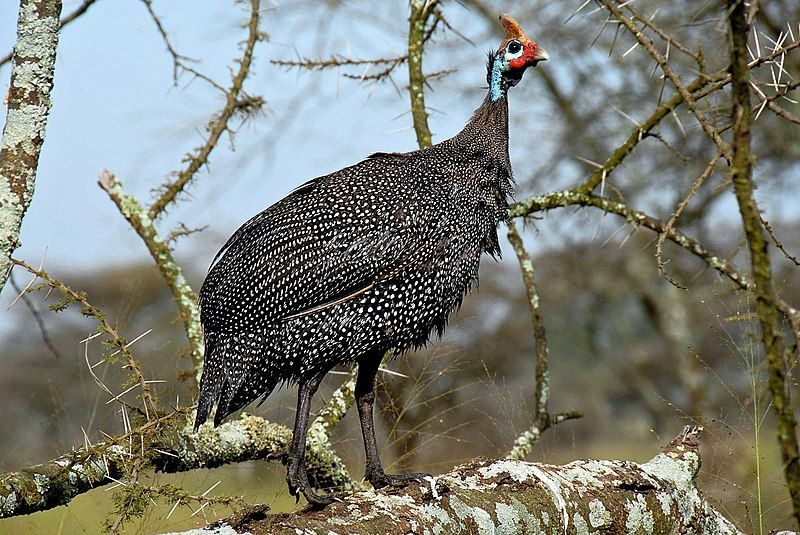
The helmeted guineafowl is a unique species of bird that belongs to the Numididae family. It is native to Africa and is mainly found in the regions south of the Sahara Desert.
This species has been domesticated and introduced into other parts of the world, such as the West Indies, North America, Colombia, Brazil, Australia and Europe.
The helmeted guineafowl is the most well-known species in the guineafowl family and the only one of its kind in the genus Numida. Due to its domestication, the helmeted guineafowl has been widely spread around the world.
They are used for ornamental purposes, such as in parks and gardens, as well as for their meat and eggs. They are also kept as pets in some countries.
The helmeted guineafowl has adapted well to a variety of climates and habitats, and they can be found in rainforests, grasslands, savannas, and even in urban areas. The helmeted guineafowl is a medium-sized bird with a distinctive crest on its head.
It has a black-and-white plumage pattern and red facial wattles. The males are larger than the females, and their feathers have a glossy sheen. They are omnivorous birds that feed on a variety of plants, fruits, and insects.
In conclusion, the helmeted guineafowl is a unique species of bird that has been domesticated and introduced to many parts of the world. It is the best-known species of the guineafowl family and is the only one of its kind in the genus Numida.
Its adaptability has allowed it to thrive in a variety of environments, and it is used for ornamental, meat, and egg purposes.
| Kingdom | Animalia |
| Phylum | Chordata |
| Class | Aves |
| Order | Galliformes |
| Family | Numididae |
| Genus | Numida |
| Species | N. meleagris |
11. Coqui Francolin
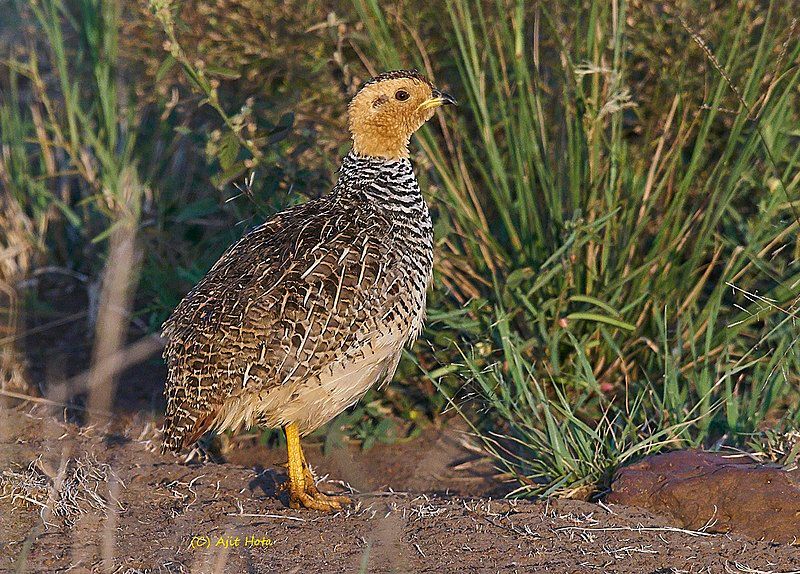
The Coqui francolin is a species of bird belonging to the family Phasianidae. This family is composed of a variety of birds, ranging from pheasants and partridges to quails and grouse. The Coqui francolin is a medium-sized bird, measuring approximately 12 inches in length.
It is native to tropical and subtropical regions of Africa, and is a terrestrial species. It is characterized by its distinctive black and grey plumage, which is speckled with white spots. The Coqui francolin is an omnivore, foraging for a variety of seeds, fruits, and insects.
It is known to inhabit grasslands, savannas, and open woodlands. It typically forms pairs or small groups, and is a relatively quiet species. They will occasionally make soft, low-pitched calls, particularly during the breeding season.
The Coqui francolin is an important species in its native habitat, as it helps to maintain the balance of the ecosystem by dispersing seeds and controlling insect populations.
| Kingdom | Animalia |
| Phylum | Chordata |
| Class | Aves |
| Order | Galliformes |
| Family | Phasianidae |
| Genus | Campocolinus |
| Species | C. coqui |
12. African Pied Wagtail
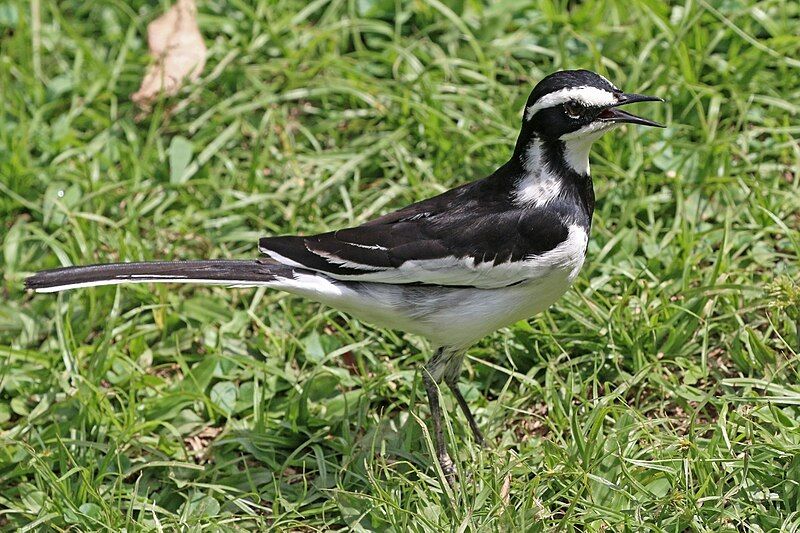
The African pied wagtail is a small bird that is found in Africa and the surrounding regions. It belongs to the family Motacillidae, which is a group of birds characterized by their distinctive tail wagging.
These birds are usually about 6-7 inches in size, and are black and white in color, with a black head and crown, and a white throat. They have long legs and long narrow wings, and they usually have a distinctive white stripe on their wings.
They are usually seen foraging for insects on the ground or in trees. They are also known to feed on seeds, fruits, and other small prey. In the wild, the African pied wagtail will typically live in small flocks, although they may also be seen flying alone.
They are known for their melodious singing, and they are often seen perching on tree branches or on the ground. This species is considered to be of least concern for conservation, with its population remaining stable.
| Kingdom | Animalia |
| Phylum | Chordata |
| Class | Aves |
| Order | Passeriformes |
| Family | Motacillidae |
| Genus | Motacilla |
| Species | M. aguimp |
13. Great Cormorant
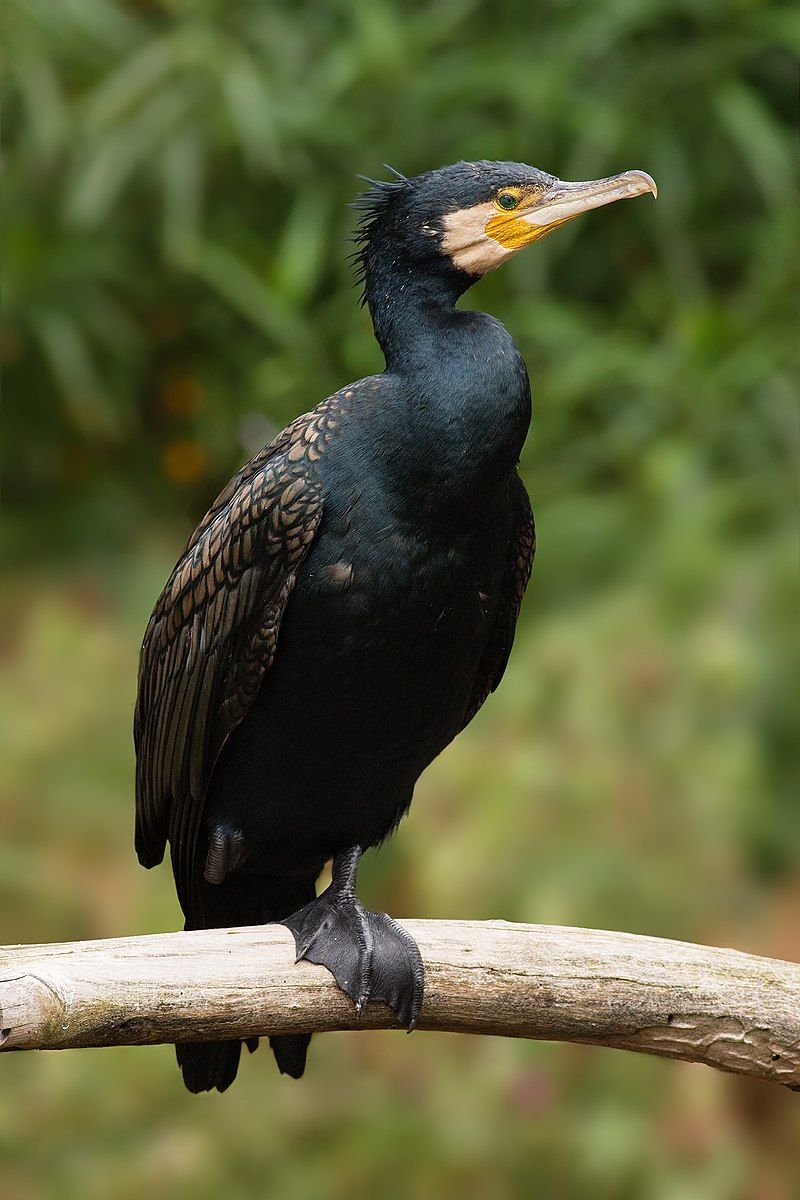
The great cormorant is a seabird that is found in many parts of the world. It is also known by many different names, depending on which part of the world it is found in. In New Zealand, it is known as the black shag or kawau.
It was formerly known as the great black cormorant in the Northern Hemisphere, the black cormorant in Australia, and the large cormorant in India. The great cormorant is a member of the cormorant family of seabirds. It is a large bird, with a wingspan of up to 1.2 meters.
It has mainly black feathers, with a white patch on its chest. Its diet consists of fish, molluscs, amphibians, and other small aquatic animals. The great cormorant nests on rocky coasts and islands, as well as on trees in sheltered areas.
It is generally a solitary bird, but can sometimes be found in large flocks when it is migrating.
It is a strong and agile flyer, and can often be seen soaring high above the ocean in search of prey. The great cormorant is a highly adaptable bird, and can be found in many different habitats across the world.
It is a common sight along coastal areas, and is a familiar sight in many harbours and estuaries. It is a protected species in many countries, and is an important part of the marine ecosystem.
| Kingdom | Animalia |
| Phylum | Chordata |
| Class | Aves |
| Order | Suliformes |
| Family | Phalacrocoracidae |
| Genus | Phalacrocorax |
| Species | P. carbo |
14. Black-Bellied Bustard
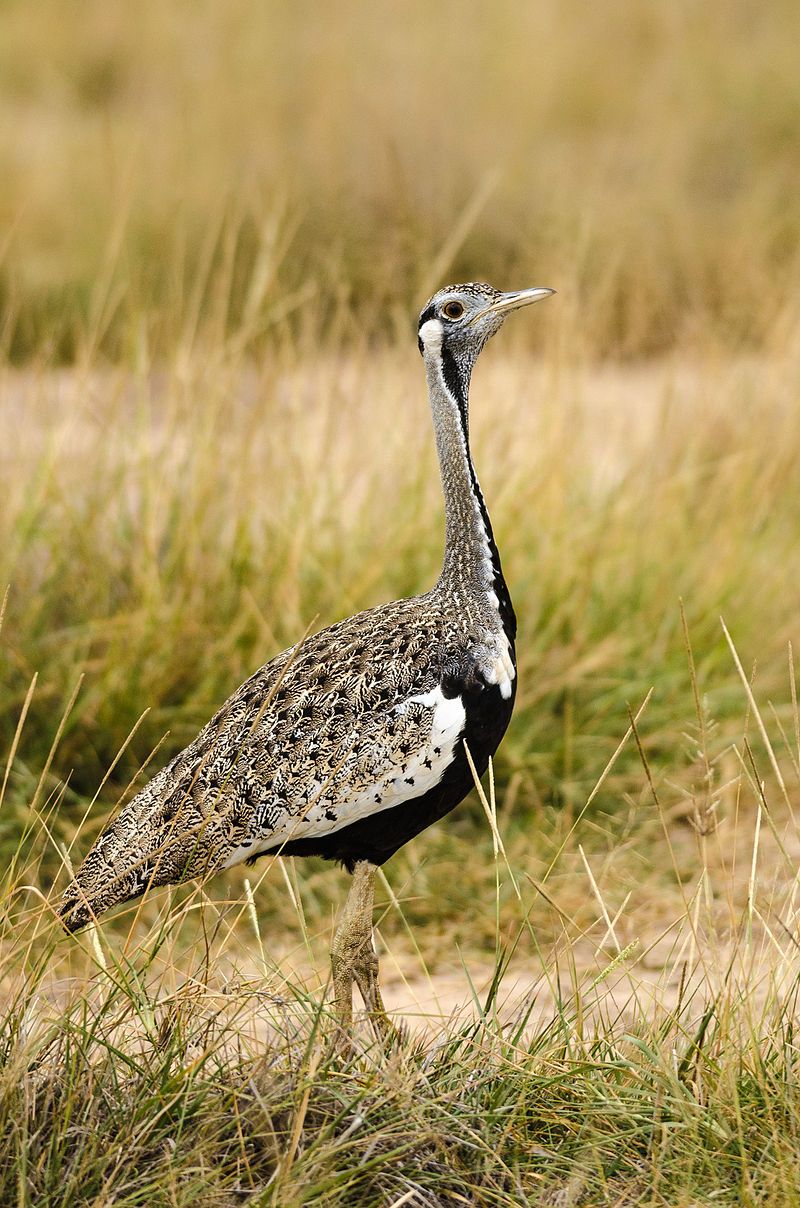
The black-bellied bustard is a unique bird species native to the African continent. It is a member of the bustard family, which is a group of large terrestrial birds that are typically found in open grasslands and savannas.
As its name suggests, the black-bellied bustard has a black belly, which stands out against its brown-grey feathers. It is also known as the black-bellied korhaan, and is sometimes referred to as the black-bellied courser.
The black-bellied bustard is a ground-dwelling bird, which means it typically stays close to the ground and avoids flying. It has long legs which it uses to travel quickly across the ground.
It is a relatively large bird, with males measuring up to 70 centimeters in length and weighing up to two kilograms. The female is usually smaller than the male, measuring up to 60 centimeters in length and weighing approximately 1.2 kilograms.
The black-bellied bustard is an omnivore, and its diet consists of a variety of small invertebrates, reptiles, amphibians, and fruits. It is a solitary bird and is usually seen alone or in small groups.
It is also known to be shy and secretive, making it difficult to observe in the wild. The black-bellied bustard is a valuable species in the African continent and is listed as a species of Least Concern by the IUCN Red List.
However, it is still threatened by habitat destruction, hunting, and other human activities. As a result, conservation efforts are being made to protect this species and its habitat.
| Kingdom | Animalia |
| Phylum | Chordata |
| Class | Aves |
| Order | Otidiformes |
| Family | Otididae |
| Genus | Lissotis |
| Species | L. melanogaster |
15. African Finfoot
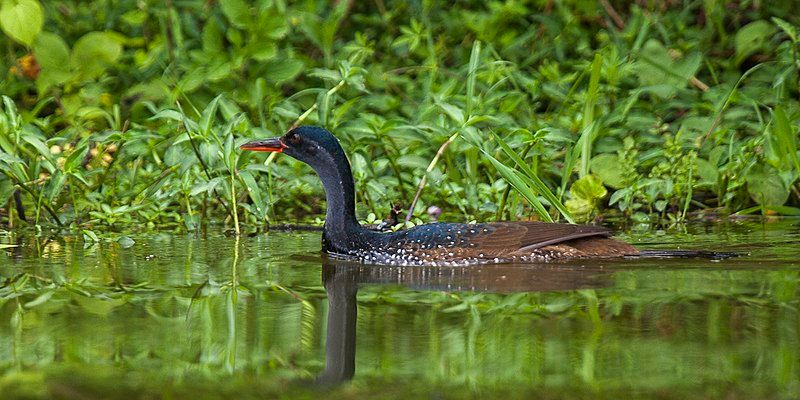
The African Finfoot is an aquatic bird that is found in the rivers and lakes of western, central, and southern Africa. It is a species of bird that is part of the family Heliornithidae which contains around 3 different species.
The African Finfoot is an unusual-looking bird with its long legs, webbed feet, and bright red bill. It has a long neck and a slender body, and its coloring is usually a combination of black, grey, and white.
It is a semi-aquatic bird, and it prefers to stay close to the shoreline, where it can find food. It is an omnivorous species, and it feeds on small fish, aquatic invertebrates, and other small prey. It is a shy and secretive bird, and it can be difficult to observe in the wild.
The African Finfoot is a vulnerable species, and it is listed as Near Threatened by the IUCN Red List of Threatened Species. It is threatened by habitat destruction and degradation, as well as hunting and trapping.
Conservation efforts are needed to protect this unique species and its habitat..
| Kingdom | Animalia |
| Phylum | Chordata |
| Class | Aves |
| Order | Gruiformes |
| Family | Heliornithidae |
| Genus | Podica |
| Species | P. senegalensis |
16. African Rail
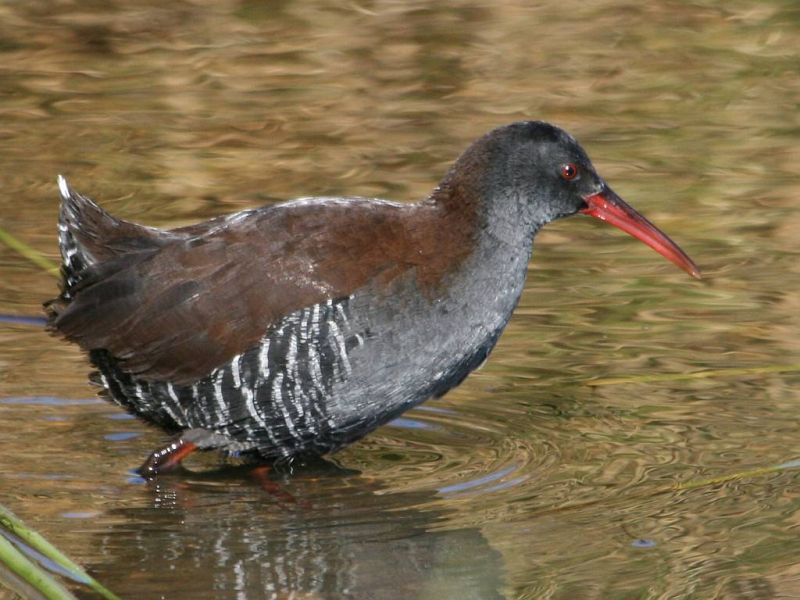
The African Rail is a species of small waterbird that belongs to the rail family, Rallidae. It is found in various parts of eastern and southern Africa, mainly in wetlands and moist grasslands.
It is a migratory species, and it moves to different areas depending on the season. The African Rail is a fairly small bird, with a length of about 16-20 cm and a wingspan of about 30-35 cm. Its body is mainly greyish-brown, with black and white barring on the back and wings.
The bill is yellowish-green, while the legs and feet are orange. The African Rail feeds mainly on invertebrates such as insects, mollusks, and crustaceans, as well as some seeds and plant matter.
It forages for food in shallow water and on mudflats, and it will sometimes pick food from the surface of the water or the vegetation. The African Rail is mostly a solitary bird, but it will form flocks during the breeding season.
The breeding season usually takes place from October to May. During this time, the male and female will build a shallow nest on the ground, lined with grass and leaves. The female will lay between 3-6 eggs, which both parents will take turns incubating.
Once the chicks hatch, the parents will feed them by regurgitating food. Overall, the African Rail is an interesting and relatively common species of wetland bird.
Though it is not considered threatened, its populations are declining due to wetland destruction and habitat degradation. It is important to protect its habitat and ensure that it has the necessary resources to survive and thrive.
| Kingdom | Animalia |
| Phylum | Chordata |
| Class | Aves |
| Order | Gruiformes |
| Family | Rallidae |
| Genus | Rallus |
| Species | R. caerulescens |
17. Red-Necked Spurfowl
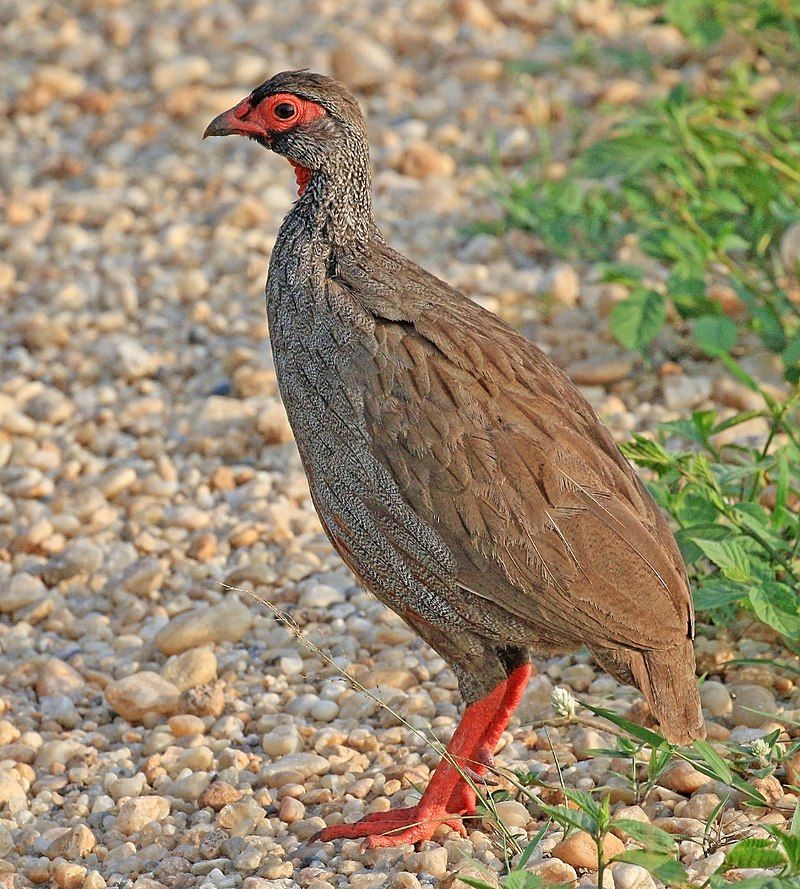
The red-necked spurfowl, or red-necked francolin, is a species of gamebird found in southern Africa. It belongs to the family Phasianidae, which includes pheasants and other game birds.
This species is a resident species, meaning that it is a permanent inhabitant of the region, rather than a seasonal migrant. The red-necked spurfowl is a medium-sized bird with a long, pointed tail and a conspicuous red patch on the back of its neck.
Its plumage is predominantly mottled brown, gray, and white, which provides excellent camouflage in its natural habitat. This species is often found in open grassland, savanna, and woodlands, where it feeds on seeds, berries, and other plant matter.
Red-necked spurfowls are also known to feed on insects, and they are often observed foraging in groups of up to twelve individuals. The red-necked spurfowl is an important game bird in the region and is hunted for sport and for its meat.
| Kingdom | Animalia |
| Phylum | Chordata |
| Class | Aves |
| Order | Galliformes |
| Family | Phasianidae |
| Genus | Pternistis |
| Species | P. afer |
18. White-Browed Coucal
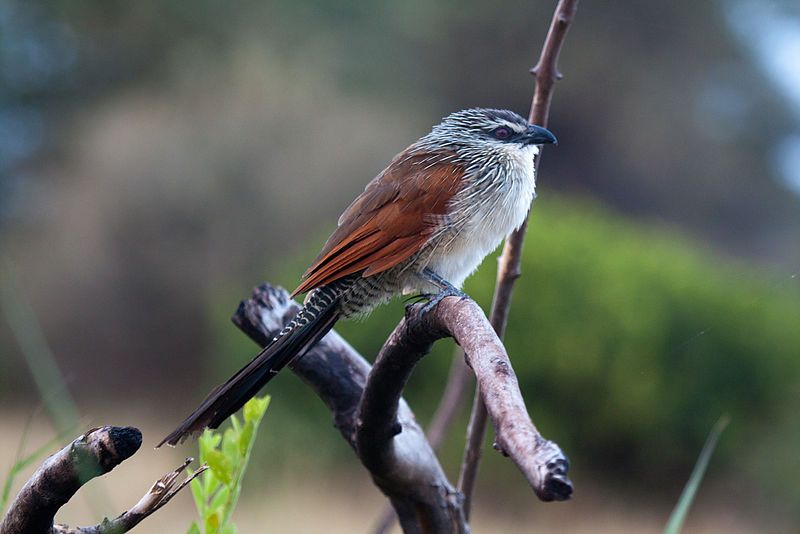
The white-browed coucal is a species of cuckoo found in sub-Saharan Africa. It is a member of the Cuculidae family, which includes several species of cuckoos.
This species prefers habitats with thick vegetation such as dense undergrowth and scrub, but can also be found in coastal regions. Burchell’s coucal is sometimes considered to be a subspecies of the white-browed coucal, although this has not been officially confirmed.
This species is relatively easy to identify due to its distinctive white-browed head and dark brown body. The white-browed coucal feeds mainly on insects, but will also consume small reptiles and mammals. It is a solitary bird, rarely seen in pairs or small groups.
It is a strong flier and can cover large distances in search of food.
| Kingdom | Animalia |
| Phylum | Chordata |
| Class | Aves |
| Order | Cuculiformes |
| Family | Cuculidae |
| Genus | Centropus |
| Species | C. superciliosus |
19. Mottled Spinetail
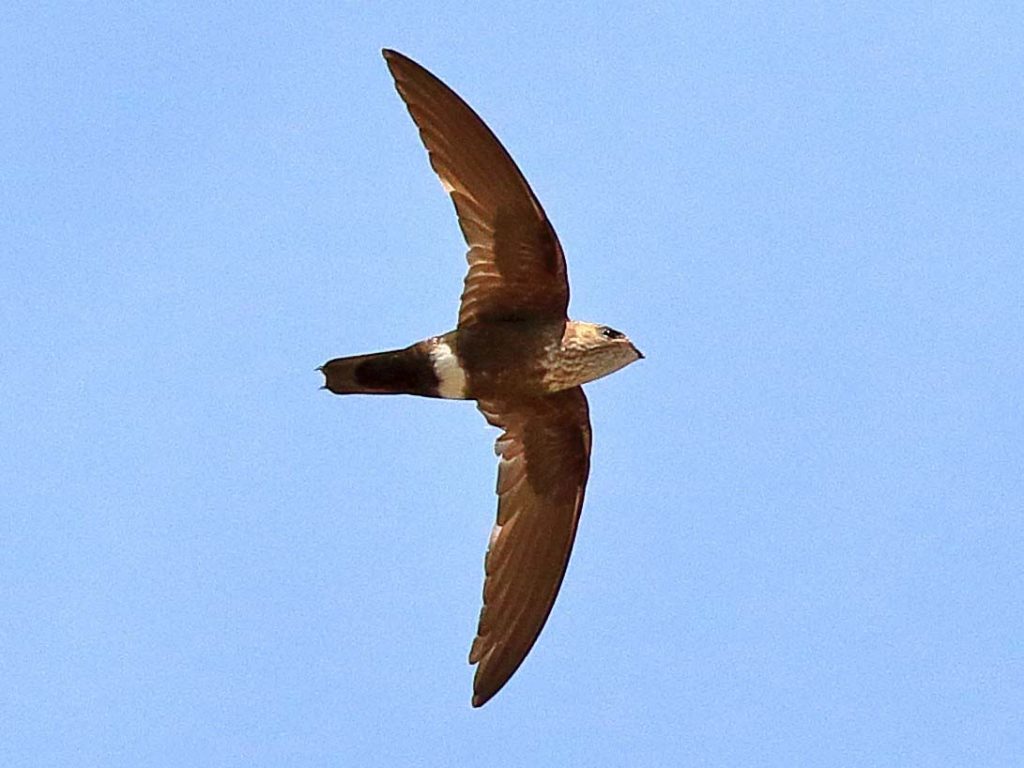
Source: ebird.org
The Mottled Spinetail is a species of swift belonging to the family Apodidae.
It is mainly found in central and western Africa and is native to Angola, Benin, Burkina Faso, Cameroon, Central African Republic, Republic of the Congo, Democratic Republic of the Congo, Ivory Coast, Equatorial Guinea, Gabon, Ghana, Guinea, Guinea-Bissau, Liberia, Mali, Niger, Nigeria, Senegal, Sierra Leone, South Sudan, and Togo.
The Mottled Spinetail is a small, sparrow-sized bird that is mainly brown or grey in color with some white and black markings. It usually feeds on insects, such as swarming termites, on the wing. It is also known to eat small fruits and seeds.
The Mottled Spinetail prefers open savannas and woodlands, but can be found in gardens and other human-made habitats too.
The Mottled Spinetail is generally considered to be of least concern on the IUCN Red List of Threatened Species, however, like many species, it is threatened by habitat destruction and degradation.
The loss of suitable habitat due to land conversion for agricultural and other uses, as well as the destruction of wetland habitats, are major threats to the species. It is also threatened by the use of pesticides and other forms of pollution.
Conservation efforts are needed to help protect the Mottled Spinetail and its habitats.
| Kingdom | Animalia |
| Phylum | Chordata |
| Class | Aves |
| Clade | Strisores |
| Order | Apodiformes |
| Family | Apodidae |
| Genus | Telacanthura |
| Species | T. ussheri |
20. African Palm Swift
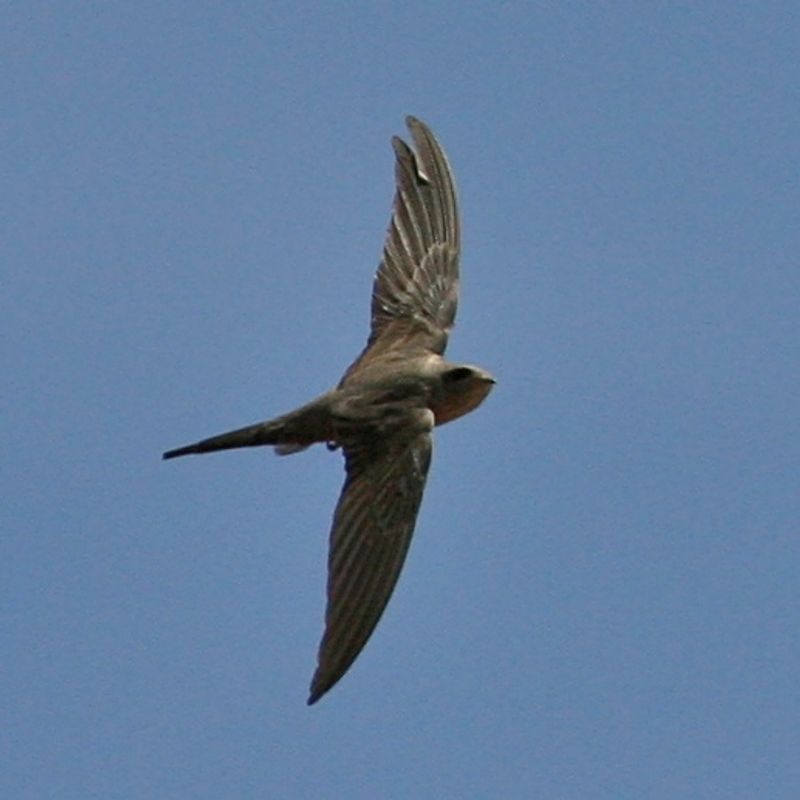
The African Palm Swift (Tachornis squamata) is a small bird species belonging to the swift family Apodidae. It is very closely related to the Asian Palm Swift (Cypsiurus balasiensis) and was previously classified as a subspecies of the same species.
However, recent studies have shown that the two species are distinct from each other and the African Palm Swift has been recognized as a separate species. Additionally, the Malagasy Palm Swift (Tachornis furcata) has also been identified as distinct from the African Palm Swift.
All these species are found in tropical and subtropical regions across Africa, the Middle East and India. The African Palm Swift is a small bird, typically measuring around 13 cm in length.
It has a distinctive black and white plumage with a forked tail, long legs and a long, slender beak. It feeds on insects, small lizards and occasionally fruits. It usually nests in the hollows of trees or in the abandoned nests of other birds.
The African Palm Swift is an aerial species and spends most of its time in flight. It is highly adapted to a life in the air, with wings that can beat up to 15 times per second and an ability to navigate with precision even in strong winds.
Its flight is usually fast and direct, and it is capable of reaching speeds of up to 70 km/h. In conclusion, the African Palm Swift is a small swift species inhabiting tropical and subtropical regions across Africa, the Middle East and India.
It is closely related to the Asian Palm Swift and the Malagasy Palm Swift, and is highly adapted to a life in the air. Its distinctive black and white plumage and fast and direct flight make it a unique sight in its native habitats.
| Kingdom | Animalia |
| Phylum | Chordata |
| Class | Aves |
| Clade | Strisores |
| Order | Apodiformes |
| Family | Apodidae |
| Genus | Cypsiurus |
| Species | C. parvus |
21. Namaqua Dove
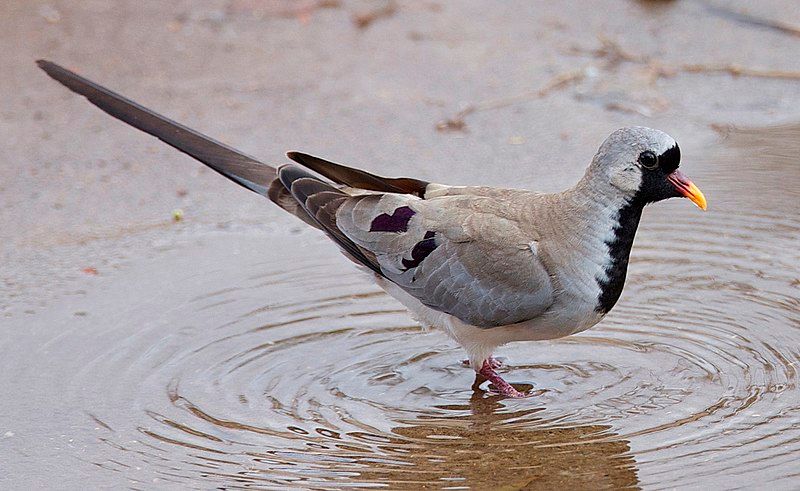
The Namaqua dove is a small pigeon that is unique in its own species, Oena. It is found in many parts of the African continent, including Sub-Saharan Africa, Arabia, and Madagascar.
This species of pigeon is known for its distinctive appearance, with its two-toned colouration of grey and pink. It is a medium-sized bird, usually between 19 and 22 cm in length, and a wingspan of between 34 and 40 cm.
Its diet consists of seeds, fruits, and some insects. The Namaqua dove has a variety of habitats, including open savannas, grasslands, and semi-arid areas. It is an adaptable species, able to survive in a range of different climates.
It is not migratory, but it may travel long distances in search of food. The dove is an important species for conservation, as it is a source of food for many predators. It is also known to be an important seed disperser, helping to spread plants over large areas.
The Namaqua dove is currently listed as least concern by the IUCN, and its population is stable.
| Kingdom | Animalia |
| Phylum | Chordata |
| Class | Aves |
| Order | Columbiformes |
| Family | Columbidae |
| Genus | Oena |
| Species | O. capensis |
22. Little Egret
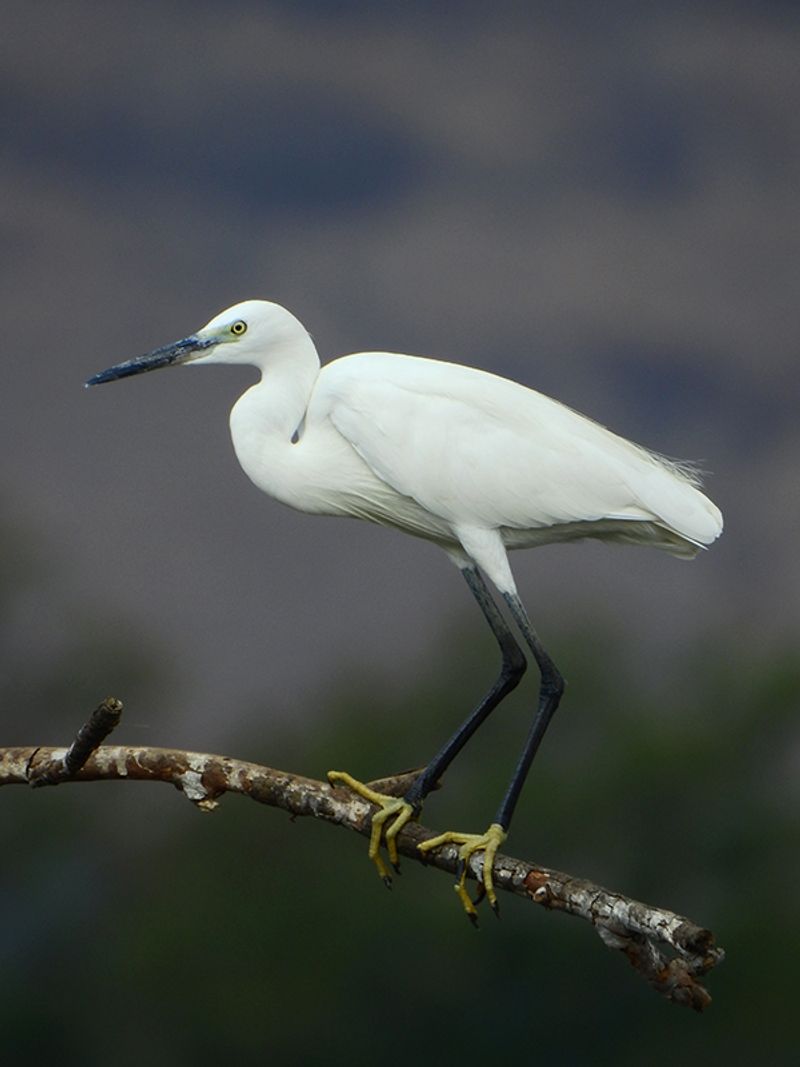
The little egret is a species of small heron found in the family Ardeidae. These white birds have a slender black beak, long black legs, and yellow feet for the western race of the species.
As aquatic birds, they feed in shallow water and on land, consuming a variety of small creatures.
This species of heron is quite widespread, being found in the tropics and subtropics of Europe, Asia, and Africa. The little egret is a graceful wading bird that can be seen in wetlands, freshwater marshes, and other bodies of water.
They forage for their food by wading in shallow water and on land, feeding on a wide variety of small creatures including fish, frogs, and insects.
The birds can also be seen in coastal areas and estuaries, where they feed on mollusks and crustaceans. The little egret has several adaptations that help it to survive in its aquatic habitat.
Its long and slender beak is ideal for reaching into tight spaces and into the mud to find food.
Its long black legs are perfect for wading in shallow water, and its yellow feet help it to have a better grip on slippery surfaces. The little egret is a widespread species, being found in the tropics and subtropics of Europe, Asia, and Africa.
It is an important part of the ecosystem, helping to control populations of small aquatic creatures. The birds are also beneficial to humans, as they consume pests that can cause damage to crops or spread disease.
| Kingdom | Animalia |
| Phylum | Chordata |
| Class | Aves |
| Order | Pelecaniformes |
| Family | Ardeidae |
| Genus | Egretta |
| Species | E. garzetta |
23. Mourning Collared Dove
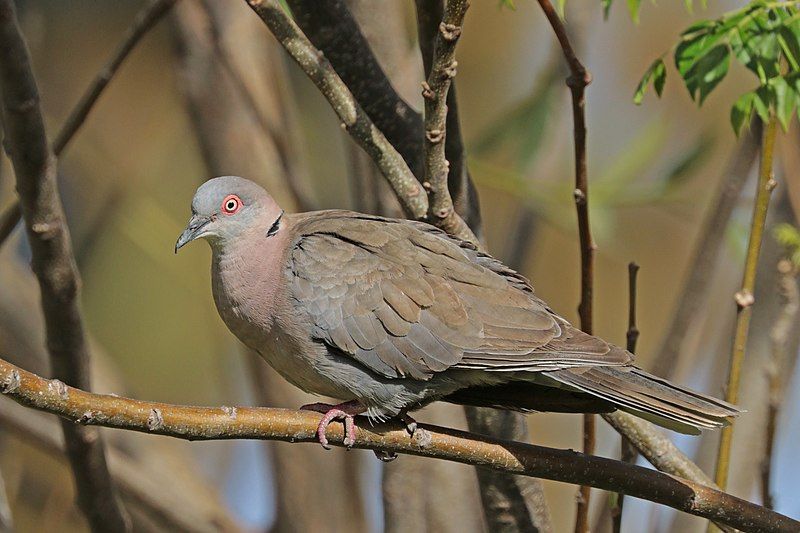
The Mourning Collared Dove, or African Mourning Dove, is a species of dove that is commonly found in Africa south of the Sahara desert. Despite its name, it is not related to the North American Mourning Dove.
This species of dove prefers to live near water and is quite abundant in these areas. They are known to be peaceful birds and often live peacefully alongside other species of doves. They have a distinctive collar on their necks which is what gives them their name.
The Mourning Collared Dove is a widely dispersed bird which is found in many areas of Africa. It is an important part of the African avian landscape and plays an important role in the environment.
| Kingdom | Animalia |
| Phylum | Chordata |
| Class | Aves |
| Order | Columbiformes |
| Family | Columbidae |
| Genus | Streptopelia |
| Species | S. decipiens |
24. Lesser Jacana
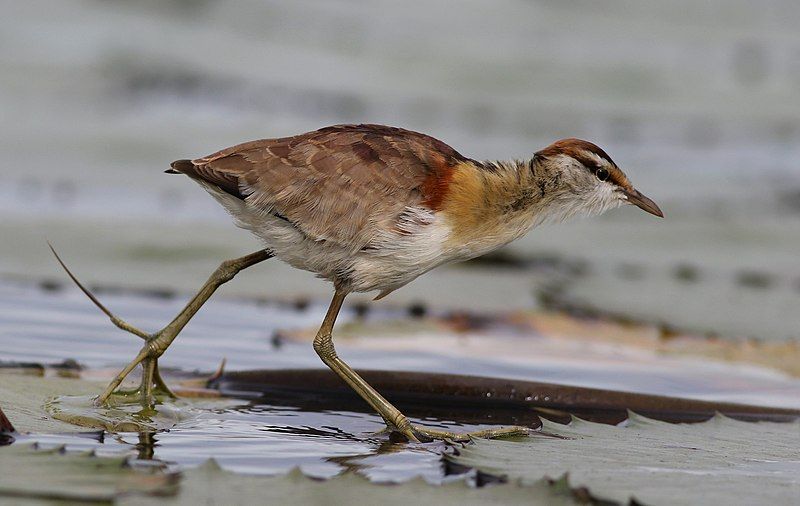
The lesser jacana is a unique species of bird found in the family Jacanidae. It is a single species within the genus Microparra, which means it is the only species in its genus.
It is a migratory bird, found in parts of southern and eastern Asia, as well as parts of Africa and South America. It is a medium-sized wading bird, with a length of around 25 cm and a wingspan of around 40 cm.
It has a striking black and white plumage, with a distinctive yellow patch on its back and yellow-tipped wings. It has long, slightly upturned toes which help it to walk on aquatic vegetation, and its diet consists of aquatic insects, crustaceans, and small molluscs.
It is a rare and endangered species, with its population declining due to the destruction of its wetland habitat. Conservation efforts are underway to help protect and preserve this unique species of bird.
| Kingdom | Animalia |
| Phylum | Chordata |
| Class | Aves |
| Order | Charadriiformes |
| Family | Jacanidae |
| Genus | Microparra |
| Species | M. capensis |
Conclusion
Birds in Mwanza are an important part of the local ecology. They provide food for other animals, help to control pest populations, and their presence can be seen in various places throughout the city.
Their songs are a source of beauty and enjoyment for many people in the area. As a result, it is important to protect and conserve the bird populations in Mwanza to ensure their continued presence in the future.